|
Through Ayrshire ...
Having said goodbye to the MacDonalds and the
Davies, we left Argyll for Galloway. On the way through Ayrshire, we happened upon a few
things that caught the eye.
Crossraguel Abbey - the Gatehouse
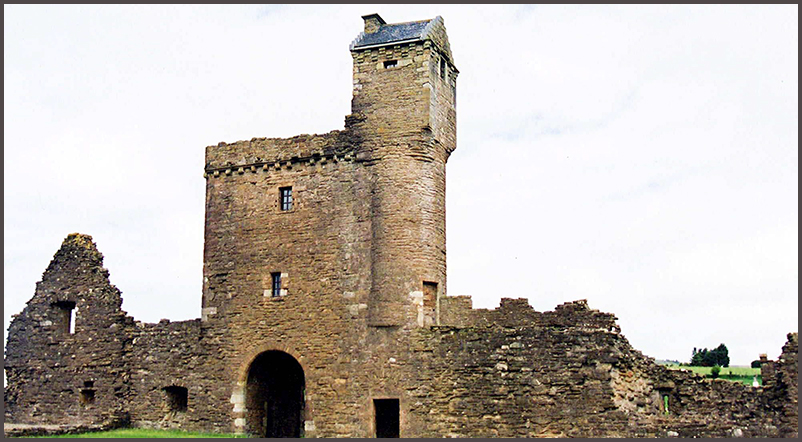
|

Chapter House |

The Cloister |

Tower House/Apartments
|

John and I in the "Eye" |
|
An abbey is a monastery governed by an abbot of the
Roman Catholic Church. Crossraguel was built in 1244 and is the most complete medieval
monastery in all of Scotland. It
includes a gatehouse, a kirk or church to the far left of the cloister, an inner court surrounding a
once-covered well, a kitchen and dining hall to the far right, a treasury up the
stairway in the facing wall, a chapter house for the friars through the doorway,
and a tower house for the abbot in the upper right corner. In the
last photo, the tower, looking darker, is seen from another angle. Beside it
are apartments that housed retired abbots and patrons no longer able to live
independently. In the early 1300s, Crossraguel Abbey was badly damaged by
the English because of its loyalty to Robert the Bruce. It was rebuilt but
eventually fell into ruin. The origin and meaning of its name remain
uncertain.
From Crossraguel, we continued south through
Ayrshire. In less than an hour's time, we came upon the timeless ...
|
|
|
|


|
|
Ailsa Craig
- This
volcanic rock island rises abruptly from the sea in the Firth of Clyde,
off the coast of Ayrshire. It measures 3,900 feet long, 2,600 wide,
and 1,114 feet high. It inspired the poet John Keats to write in
1818: |
|
Hearken, thou craggy ocean-pyramid! ...
how long is't since the Mighty Power bid
thee heave to airy sleep from
fathom dreams?
Sleep in the lap of thunder, or sunbeams,
or when grey clouds
are thy cold coverlid?
Thou answer'st not, for thou art dead asleep!"
Pleasure trips to the Craig are available for sailing around the island, going
ashore to visit its lighthouse and ruined castle, or seeing its gannets and puffins. We merely drove by, took a few
photos, and continued on through the countryside.
We were on a quest and went from Ayrshire ...
... to Galloway
|

District Welcome Sign
The Bonnie Hills
 |
In Search of Linn's Tomb
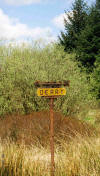
Sign for Derry Farm |
|

Derry Farm Ruin
Loch Derry
 |
|
A
land of both beauty and starkness, Galloway is also, like most of Scotland, a land of
both tragedy and triumph. Seeking a
300-year-old tomb, we drove a narrow, unpaved section of the Southern Upland Way
and hiked up the rocky, sometimes boggy moor of Craigmoddie Fell.
We looked for the stone wall enclosure that Ranger Mearns had
said surrounds the grave. Arriving at the first structure that caught our
eye, we discovered it was an old, stone sheep pen. Had it belonged
to the man whose grave we sought? We headed back down a bit and looked up
in a slightly different direction. There was something else. We
walked toward it, hoping it was the object of our quest.
|

A Sheep Pen |

There ... |

The Tomb
|
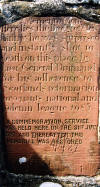
Original Stone |
|
In the spring of 1685, a simple shepherd from Derry
Farm named Alexander Linn was tending his sheep on the moor. He was
reading a pocket Bible, and it was the peak of the Killing Time.
Lieutenant-General William Drummond, whose brutal,
relentless pursuit of Covenanters had earned him the name "Herod"
Drummond, was leading
|
|
his men across southern Ayrshire. As they
approached Galloway, a number of lapwings flying in the distance
suggested that some danger was threatening their
nests.
Suspecting the cause of the birds' distress was human, Drummond
led his men across the
border. Approaching the fell, they saw Linn and circled around to take him
by surprise. When they found him reading a Bible, Drummond decided that
was cause enough to condemn him. At that point in history, you see,
lay persons were forbidden to own Bibles and were directed instead to obtain
instruction in the scriptures directly from priests. A Scottish shepherd in
possession of a pocket Bible surely must have been a Presbyterian. And so,
Alexander Linn was ambushed, shot, and killed for his faith.
When his
lifeless body was later found, he was buried on the spot where he had died and
a memorial stone was erected. The
place was later described by Rev. William Mackenzie as "a bleak, romantic spot". Over the succeeding 300 years, at least five
memorial services were held at Linn's tomb, the stone enclosure was built, and two
additional, commemorative stones were added.
|
On that spring day in 1685, what words of God
were last on the heart and mind of Alexander Linn? What promises of
the Lord ushered him into his heavenly home as he left his earthly abode?
On the hills surrounding his tomb,
sheep still graze. |
|

Sheep Still Graze
|
From the martyr's tomb, we traveled east and drove along "the silv'ry
winding Cree".
The Winding Cree and Stravaiger's Rest
|

  

The Cree flows south from
Ayrshire into Galloway and on to Wigtown Bay. It takes many turns and has many looks, all of them beautiful. A stravaiger is a wanderer
but
can be either one who roams without purpose or direction, or one who travels
purposefully but unhindered through a wide area. This modern stone,
set by the river in Galloway, is dedicated to travelers past and present,
wishing well to all who pass, whether attending to mundane affairs or
pursuing great adventures. We took the greeting to heart and continued our own little adventure, stopping
next in Creetown.
|
Kirkmabreck Parish Church
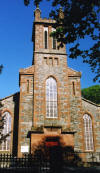 |
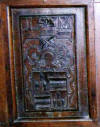 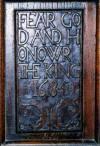 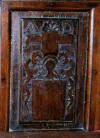
 |
Creetown's 1834 church was the third building for the parish. The
first, erected in 1645, now stands in ruins high on a hill near Fell Quarry. As we
took our picture, the custodian arrived and kindly invited us in. We admired the long wood
panel, which once constituted the back of a family pew, and were told it had been taken from the old church building and brought
to the new. Some of the panel's insets bear various coats of arms. The admonition carved on one ~ Fear God and Honowr the King ~
had guided the early Presbyterians to honor those in authority while
preserving the right of Christ, and not the king, to govern the Church. The last Scottish National
Covenant was signed in 1684.
Thanking our gracious host, we
continued on our journey, traveling southeast along the bay into which the River
Cree empties. The one misfortune of our adventure was that we seemed to
arrive at such places always when the tides were out.
The Bay of Wigtown
|
 |
In 1685, an elderly Margaret
McLachlan and teenaged Margaret Wilson refused to renounce their faith and
were tied to stakes in Wigtown Bay to drown in the incoming tide.
Though jeered and taunted, they held fast to their faith to the end. |
Threave
Castle |
|
On the
way to our next bed and breakfast, we saw a sign for a castle that was
not on our list. We stopped to inquire and learned that it sits on
an island in the River Dee with a ferry crossing for tours. |
 |
|
Alas! we had arrived just as the ferry was retiring for the day.
Nevertheless, we enjoyed a quiet walk from the car through pastoral fields
and lovely woods to the banks of the River Dee.
The island on
which Threave Castle sits was the site of an older stronghold dating as
early as the eleventh century, when Fergus, Lord of Galloway, ruled here.
That fortress is believed to have been destroyed in 1308 by Edward,
brother of Robert Bruce, after he defeated the Gallovidians on the banks
of the Dee. In the 1370s, Archibald, 3rd Earl of Douglas and Lord of
Galloway, built Threave Castle to secure his hold on the region and defend against incursions by the English, who ever persisted in their
attempts to seize Scotland. The castle once was considerably
larger than this remaining tower house suggests and at the time was
surrounded by a small
village.
|
__________________________________________________________________________________________________
If you came from the Bed and Breakfasts page, use your browser's Back Button to
return to the appropriate place on that page.
If you came from a search, click here to begin at the
beginning:
Home
Contact
Copyright 2018 · Loretta Lynn Layman · The House of
Lynn
|




























